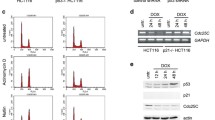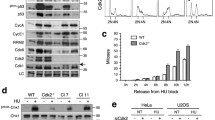Abstract
This study analyses whether the inability of p53 to induce G1 arrest after the restriction point relates to an inability to modulate pRb phosphorylation. Transient p53 overexpression in normal human diploid fibroblasts and p53-deficient cancer cells led to increased levels of the cyclin-dependent kinase inhibitor p21Cip1/Waf1/Sdi1 and an accumulation of hypophosphorylated pRb in cells growing asynchronously and in cells synchronized in late G1 or M. Similarly, γ-irradiation of asynchronous, late-G1, or S phase fibroblasts led to an increase in hypophosphorylated pRb. Experiments with fibroblasts expressing the HPV16 E6 protein indicated that accumulation of hypophosphorylated pRb required functional p53. Progression into and through S phase was not altered by the presence of hypophosphorylated pRb in late G1, consistent with the failure of p53 to mediate G1 arrest in cells that are past the restriction point. These data indicate that accumulation of hypophosphorylated pRb has significantly different effects on cell cycle progression in early G1 versus late G1 or S phase.
Similar content being viewed by others
Author information
Authors and Affiliations
Rights and permissions
About this article
Cite this article
Linke, S., Harris, M., Neugebauer, S. et al. p53-mediated accumulation of hypophosphorylated pRb after the G1 restriction point fails to halt cell cycle progression. Oncogene 15, 337–345 (1997). https://doi.org/10.1038/sj.onc.1201200
Received:
Revised:
Accepted:
Issue Date:
DOI: https://doi.org/10.1038/sj.onc.1201200
- Springer Nature Limited
Keywords
This article is cited by
-
Radiation-induced cell cycle perturbations: a computational tool validated with flow-cytometry data
Scientific Reports (2021)
-
The evolution of diverse biological responses to DNA damage: insights from yeast and p53
Nature Cell Biology (2001)
-
2-Acetaminofluorene blocks cell cycle progression after hepatectomy by p21 induction and lack of Cyclin E expression
Oncogene (1999)
-
Involvement of retinoblastoma (Rb) and E2F transcription factors during photodynamic therapy of human epidermoid carcinoma cells A431
Oncogene (1999)




